Separation Of Substances
Those materials that contain one or more than one type of constituent particles or components are called substances. These occur in nature both in pure and impure or mixed forms.

Pure Substances
These are substances that are made up of only one kind of particle, for example, silver, gold, iron, etc. They cannot be separated into two or more substances.
Read and Learn More Class 6 Science Notes
Mixtures or Impure Substances
These are the substances made up of two or more pure substances, for example, air is a mixture of many gases like nitrogen, oxygen, and carbon dioxide. The different substances present in a mixture are called its components or constituents.
The constituents of a mixture are segregated from each other by a process called separation. For example, grain is separated from stalks, tea leaves are separated from the liquid with a strainer while preparing tea, milk, or curd is churned to separate the butter.
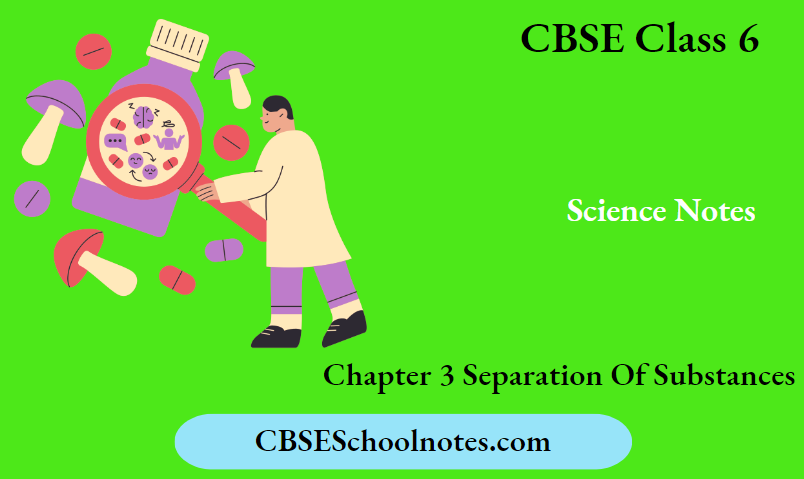
Purposes Of Separation Of Substance
Most substances that occur in nature may contain one or more useful substances or one useful substance and one or more harmful or unwanted (undesirable) substances.
To make the available substance fit for use, these impurities must be separated from the useful substance. The substances to be separated may be particles of different sizes or materials. These may be solids, liquids, or even gases.
The separation of substances is carried out for the following purposes
- To remove impurities or harmful components For example, small pieces of stones and undesirable seed grains are removed from rice and dais before cooking. The useless pieces of stones and seed grains are thrown away.
- To remove non-useful components, For example, tea leaves are separated from the liquid with a strainer while preparing tea.
- To separate two different, but useful components A mixture may contain one or more useful constituents. These should be separated for their proper use. For example, milk or curd is churned to obtain butter and buttermilk.
Methods Of Separation
Separation of useful substances from unwanted substances is very common in our day-to-day lives and laboratories/industries. In day-to-day life, we use simple methods to carry out separation.
Some most commonly used methods for separating the constituents of a mixture are shown below

Handpicking
The process of separating solid particles from a mixture by hand is called handpicking. This method is used to separate slightly larger-sized particles present in small quantities (impurities) like stone, husk, pieces of dirt, etc. from the grains of wheat, rice, pulses, etc.
Hence, in such cases where the quantity of such impurities is not very large, handpicking is a convenient method of separating substances.

Threshing
It is the process of separating grains from stalks of harvested crops. Fully matured crops like paddy (rice) or wheat are harvested from the field. During this, the crop plants are cut close to the ground.
Stalks are dried in the Sun before the grains are separated. Each stalk has many grains attached to it. The grains attached to the stalks are covered in a thin layer called chaff.
The grains are then separated from stalks by the process of threshing. In this process, the stalks are beaten to free the grain seeds.
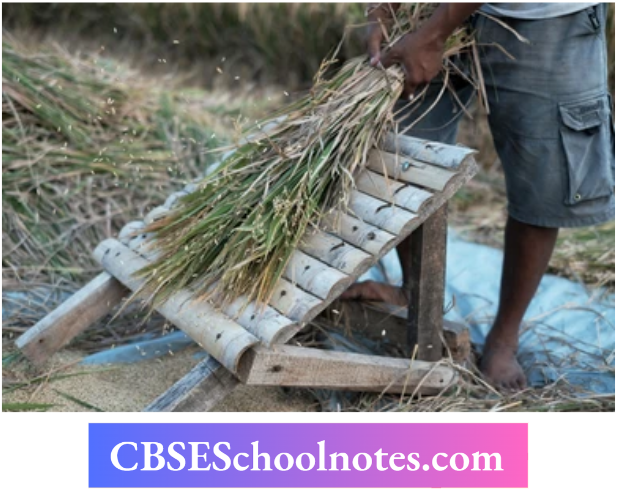
Threshing can be done by following the ways
- By holding the bundles of stalks in hand and beating them on hard surfaces.
- By allowing bullocks to trample the stalk.
- By machines, in case of large quantities of grains.
Winnowing
The method used to separate heavier and lighter components of a mixture by wind or by blowing air is called winnowing.
This method is commonly used by farmers to separate lighter husk particles (thin, dry outer covering of various seeds) from heavier seeds of the grains.
The steps involved in the separation of husk from grains with the help of wind are as follows
- The mixture of wheat grains and husk is taken in a winnowing basket (also called chhaaj in Hindi) plate or newspaper.
- Farmers take this mixture in open ground and stand on a risen or elevated platform.
- The winnowing basket containing the mixture is held at shoulder height then the mixture is allowed to fall by shaking the basket continuously.
- As a result, lighter husk particles are carried away by the blowing wind. Heavy wheat grains fall straight to the ground and form a heap near the platform for winnowing.
- The separated husk is used for many purposes such as fodder for cattle.
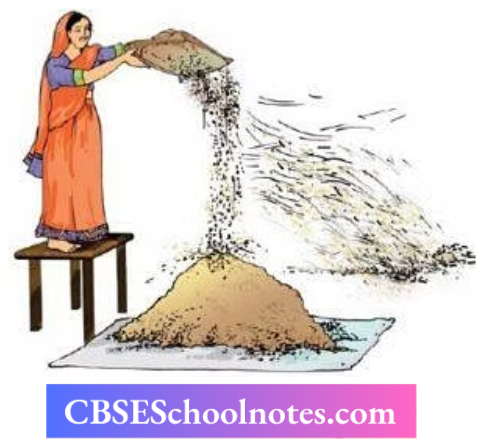
Sieving
- The process of separating very fine particles from bigger ones by using a sieve is called sieving. In this method, a sieve having small holes at its bottom is used.
- The sieves can be of different sizes which depends on the size of the substances to be separated. Sieving is used when components of a mixture have different sizes.
- Some examples of separation of mixtures by sieving are as follows
Sieving allows the fine flour particles to pass through the sieve holes while the bigger impurities (Bran-outer coarse part of the grain) remain on the sieve
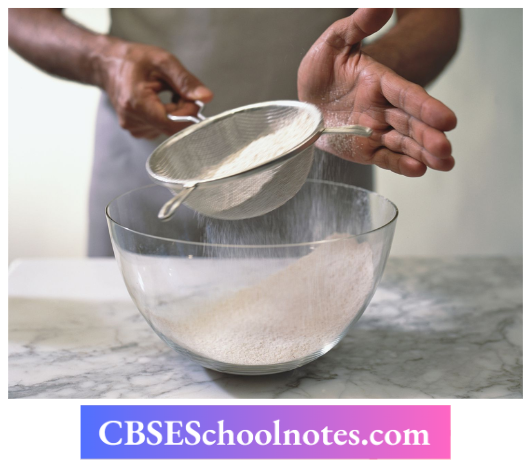
Science Insight Sieving of wheat flour is not considered a healthy practice because wheat bran which is removed during sieving is a rich source of fibre.
- On a large scale, such as in a flour mill, impurities like stones and husk are removed from grains before grinding them. Usually, a hag full of wheat grains is poured on a slanting sieve.
- The sieve removes pieces of stones, stalks, and husks that may remain with wheat grains after threshing and winnowing Similar slanting sieves are used at construction sites to separate pebbles and stones from coarse sand.
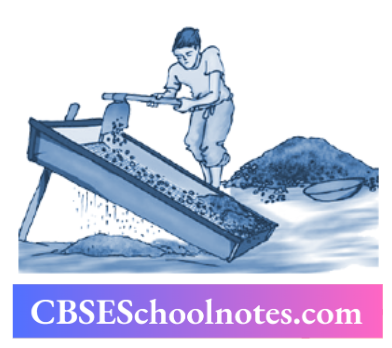
Sedimentation, Decantation and Filtration
We observed that sometimes, separation of the mixture is not possible with the help of winnowing and handpicking as there may be lighter impurities present such as dust or soil particles. So, we use other methods for the separation of such a mixture. These methods are as follows
Sedimentation
The process of settling down of insoluble heavy solid particles in a mixture at the bottom of the vessel is known as sedimentation. For example, when we mix up sand and water in a glass and stir it with a spoon or any other tool and wait for some time, we see that the sand settles down at the bottom and clear water stands on it.
The solid settled at the bottom of the glass is known as sediment and the clear liquid above is known as supernatant.
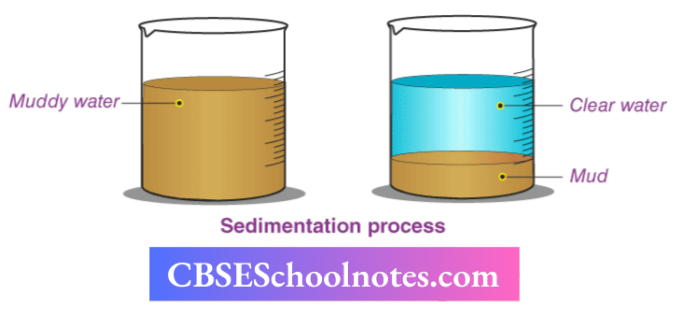
Decantation
The process of transfer or separation of clear liquid from one vessel to another vessel without disturbing the sedimented particles is known as decantation. For example, transfer of water to another vessel from a mixture of water and sand.
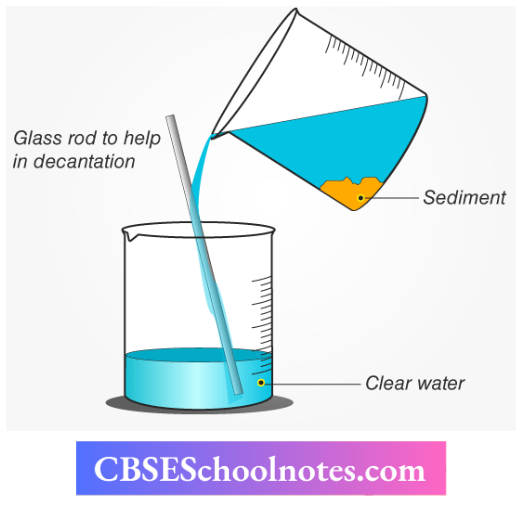
The same principle is used for separating a mixture of two liquids, that do not mix, example oil and water can be separated from their mixture by this process.
If a mixture of such liquids, which do not mix, is allowed to stand for some time, they form two separate layers. The component that forms the top layer (i.e. oil) can then be separated by decantation.
Filtration
The process of removing insoluble solid particles from a liquid by using a filter is known as filtration. Common examples of filters used are sieve, muslin cloth, and filter paper.
Some examples of separation mixtures by filtration are as follows
- Separation of tea leaves from prepared tea by using a strainer.
- Fruit and vegetable juices are usually filtered before drinking to separate the seeds and solid particles of pulp.
- The method of filtration is also used in the process of preparing cottage cheese (paneer) in our homes. You might have seen that for making paneer, a few drops of lemon juice are added to milk as it boils.
- This gives a mixture of solid particles of paneer in a liquid. The paneer is then separated by filtering the mixture through a fine cloth or a strainer. Sometimes water supplied through taps or water that is collected from ponds or rivers may be muddy, especially after rains.
- Therefore, we can use sedimentation, decantation, and filtration processes in a sequence to make the water suitable for usage
Science Insight Our kidneys act as a filter to clean the blood. Waste chemicals dissolved in the blood pass through a membrane in the kidneys and are excreted as urine acts or gets filtered.
Evaporation
The process of conversion of water into its vapor is called evaporation. Heat and wind help in the evaporation of water. The process of evaporation takes place continuously, wherever water is present.
This process is used to obtain a solid material that has dissolved in water or any other liquid. The dissolved substance is left as a solid residue when all the liquid gets evaporated. For example, obtaining salt from seawater.
Sea water contains large amounts of salt dissolved in it. One of these salts is the common salt. Now, understand the way by which it can be obtained.
When seawater is allowed to stand in shallow pits, water gets heated by sunlight and slowly turns into water vapor through evaporation.
In a few days, the water evaporates completely leaving behind the solid salts. Common salt is then obtained from these solid salts by further purification.
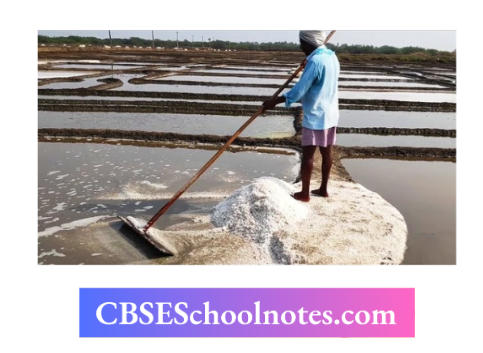
Condensation
The process of conversion of water vapor into its liquid form is called condensation. The process of condensation is the opposite of evaporation. In this process, water vapor condenses into a liquid after making contact with the cooled surface.
This method is used when the solid and liquid both need to be recovered, for example, the separation of pure water from salt solution.
Use Of More Than One Method Of Separation
We have studied some methods for the separation of substances from their mixtures. Often, only one method is not sufficient to separate the different substances present in a mixture.
In that situation, we need to use more than one of these methods, for example, the mixture containing salt, sand, and water cannot be separated by a single separation method. With the help of activity 3, we can easily understand the process of separation of a mixture with the help of more than one method.
Solution
It is a mixture in which a substance completely dissolves in a liquid. Here, the substance that dissolves in a liquid is called solute (smaller quantity), while the liquid in which solute is dissolved is called solvent (larger quantity). Solute + Solvent = Solution for example, in a salt solution, salt is the solute and water is the solvent.
Science Insight Water is considered the ‘universal solvent1 as it dissolves a large number of substances in it.
Saturated Solution
We have noticed that many substances dissolve in water and form a solution. But when more and more quantity of these substances are added to a fixed quantity of water, at a given temperature substances remain undissolved and settled down, this means that no more substance can be dissolved in the amount of water we have taken. Such a solution is called a saturated solution. In other words, a solution in which no more soluble substance can be dissolved at a given temperature is called a saturated solution.
Activity 1
Aim: To separate clear water from muddy water by using processes like sedimentation, decantation, and filtration.
Materials Required: 2 glasses, muddy water, filter paper/piece of cloth, funnel, etc.
Procedure:
- Take half a glass of muddy water. Let it stand for half an hour.
- We observe that after some time, soil settles at the bottom. This process is called sedimentation.
- Now, slightly tilt the glass without disturbing the sedimented soil. Let the water from the top flow into another glass. This process is called decantation.
- The water in the second glass is still muddy or brownish.
- To filter this muddy water first fold the filter paper to make a cone then fix this cone onto the funnel. Pour the muddy water through it.
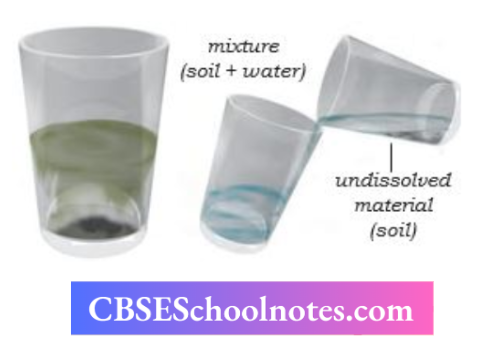
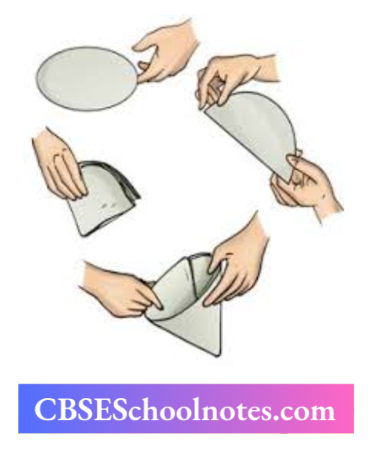

Observation: Solid particles in the mixture do not pass through the funnel and remain on the filter paper. Conclusion We can conclude that the given muddy water can be turned into clear water by using the processes of sedimentation, decantation, and filtration.
Activity 2
Aim: To separate salt dissolved in water by evaporation.
Materials Required: Salt, water, teaspoon, beaker (150 mL), burner, tripod stand, wire mesh, China dish, etc.
Procedure:
- Take a teaspoon of salt and dissolve it in lOOmL of water in a beaker.
- Heat the beaker containing salt and water as shown in.
- Continue the heating process until the water gets completely vapourised
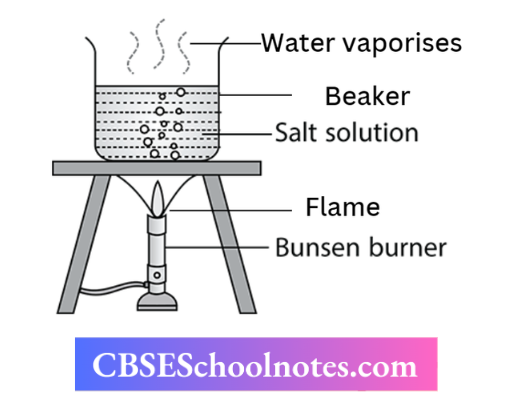
Observation: After the complete vapourization, there is a white residue left behind in the beaker. Now scrap it out in a China dish and taste it. It is a salt.
Conclusion: We conclude that a substance (like salt) which is soluble in a liquid (like water) forming a salt solution, can be separated through the process called evaporation.
Activity 3
Aim: To separate salt and sand present in water.
Materials Required: Sand, salt, beakers, water, glass rod, kettle, metal plate, ice, burner, etc.
Procedure:
- Take a mixture of sand and salt. Keep this mixture in a beaker.
- Add a small quantity of water to the beaker and stir the solution with the help of a glass rod. After stirring, allow it to stand for some time.
- We observe that salt dissolves in water and sand settles at the bottom ofthe beaker.
- Separate sand from solution by decantation or filtration.
- Now, we need to separate salt from the remaining mixture of salt and water.
- Transfer this liquid to a kettle and close its lid. Heat the kettle for some time.
- We notice that the steam comes out from the spout of the kettle.
- Now, take a metal plate with some ice on it.
- Hold the ice plate just above the spout ofthe kettle. We will observe that when the steam comes in contact with the metal plate, it gets cooled down by ice.
- The water droplets fall from the plate and get collected in a separate beaker. This process is called condensation.
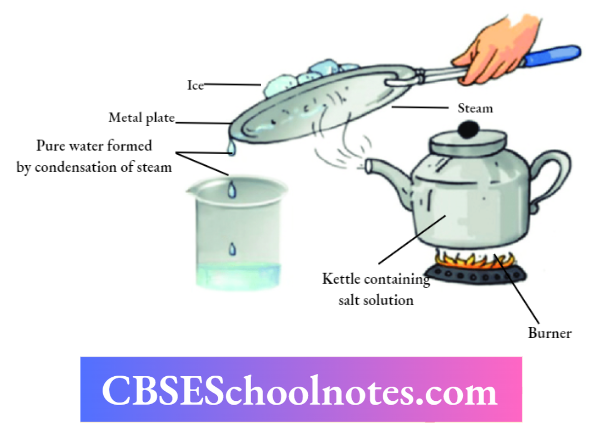
Observation: We have thus, separated sand (in step 4), and collected water in a separate beaker, and at the end of the activity the white residue left in the kettle is salt.
Conclusion: We conclude that processes of decantation, filtration, evaporation, and condensation are used to separate a mixture of salt, sand, and water.
Activity 4
Aim: To prepare a saturated solution of salt in water.
Materials Required: Spoon, tumbler/ glass, water, salt, glass rod, etc.
Procedure:
- Take a tumbler/glass and put 150 mL of water in it.
- Add one teaspoonful of salt to the water and stir it with a spoon or glass rod until the salt dissolves completely.
- Again, add a teaspoonful of salt and stir it well.
- Continue adding salt to water with constant stirring to dissolve it.
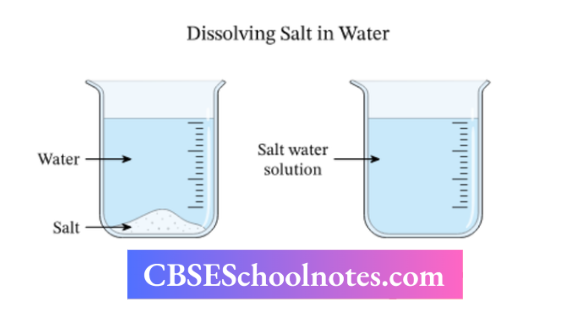
Observation: After adding many spoons of salt, it is observed that some salt is left undissolved at the bottom of the tumbler even after stirring. The solution is now said to be saturated.
Conclusion: We conclude that when no more amount of solute (salt) can dissolve in the solvent (water), the solution is called a saturated solution.
Activity 5
Aim: To show the effect of heating on the saturated solution of salt and water.
Materials Required: Tumbler/beaker, water, glass rod, salt, burner, tripod stand, wire mesh, etc.
Procedure:
- Take some water in a tumbler or beaker.
- Add salt with continuous stirring with the help of a glass rod until it becomes a saturated solution.
- Now, add a small quantity of salt to this saturated solution and heat it.
- Let this hot solution cool down and observe it.

Observation: After heating the saturated solution, it is observed that the undissolved salt at the bottom of the beaker gets dissolved. However, after cooling down the solution, the salt appears to be settled at the bottom of the beaker again.
Conclusion: We conclude that there is an effect of heating (temperature) on the saturated solution and thus, a larger quantity of salt can be dissolved in water on heating.
